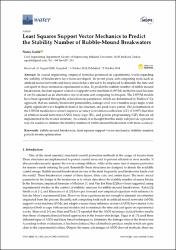Least squares support vector mechanics to predict the stability number of rubble-mound breakwaters

View/
Access
info:eu-repo/semantics/openAccessAttribution 3.0 United Stateshttp://creativecommons.org/licenses/by/3.0/us/Date
2018Metadata
Show full item recordAbstract
In coastal engineering, empirical formulas grounded on experimental works regarding the stability of breakwaters have been developed. In recent years, soft computing tools such as artificial neural networks and fuzzy models have started to be employed to diminish the time and cost spent in these mentioned experimental works. To predict the stability number of rubble-mound breakwaters, the least squares version of support vector machines (LSSVM) method is used because it can be assessed as an alternative one to diverse soft computing techniques. The LSSVM models have been operated through the selected seven parameters, which are determined by Mallows' Cp approach, that are, namely, breakwater permeability, damage level, wave number, slope angle, water depth, significant wave heights in front of the structure, and peak wave period. The performances of the LSSVM models have shown superior accuracy (correlation coefficients (CC) of 0.997) than that of artificial neural networks (ANN), fuzzy logic (FL), and genetic programming (GP), that are all implemented in the related literature. As a result, it is thought that this study will provide a practical way for readers to estimate the stability number of rubble-mound breakwaters with more accuracy.
Source
WaterVolume
10Issue
10Collections
The following license files are associated with this item:


















